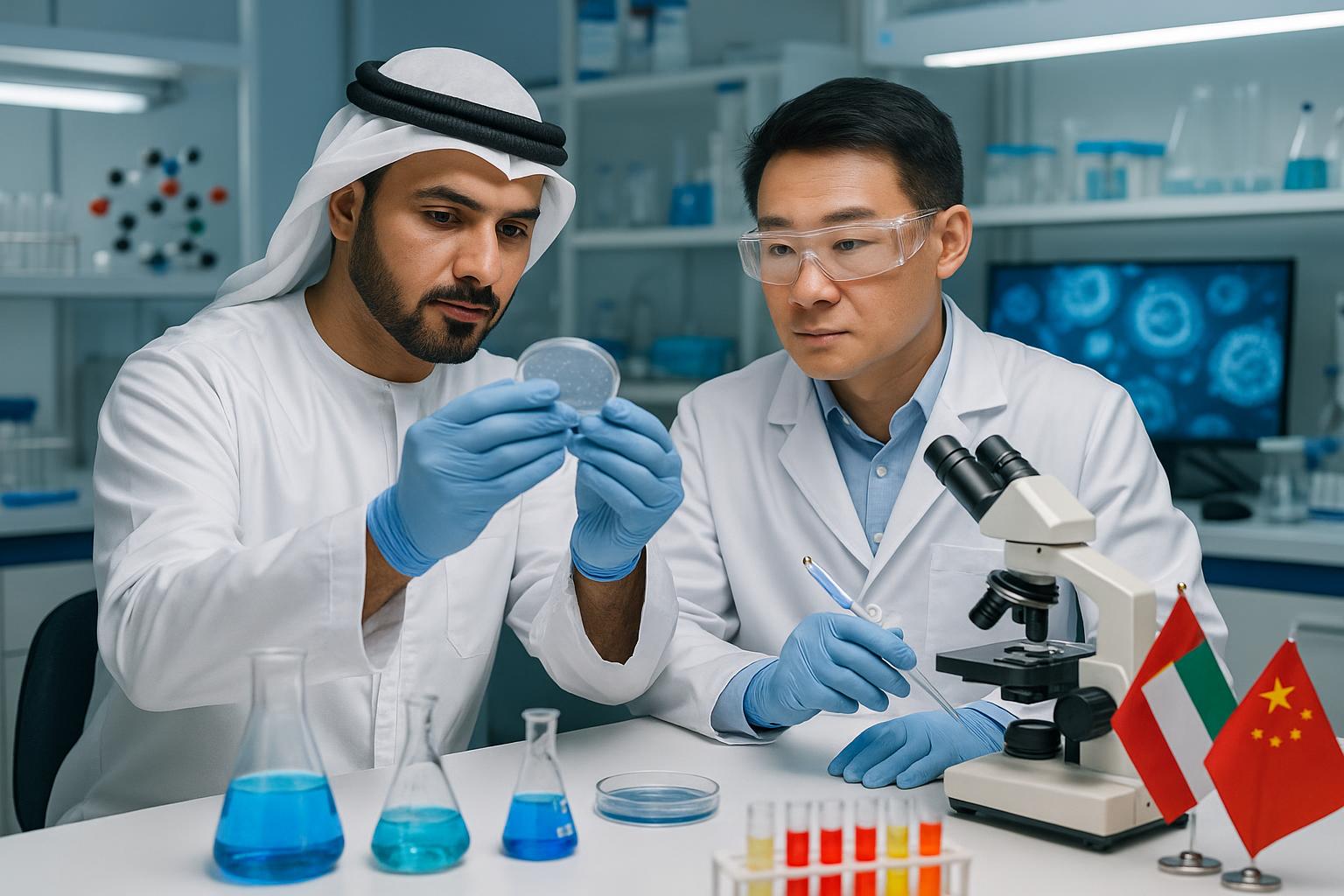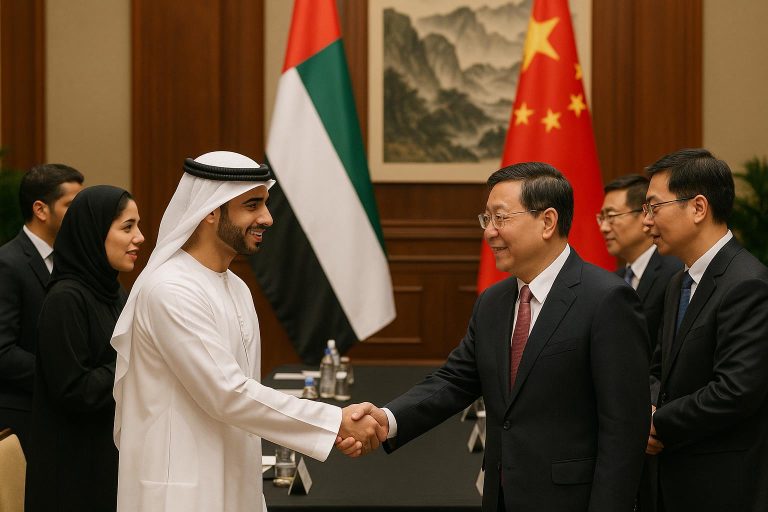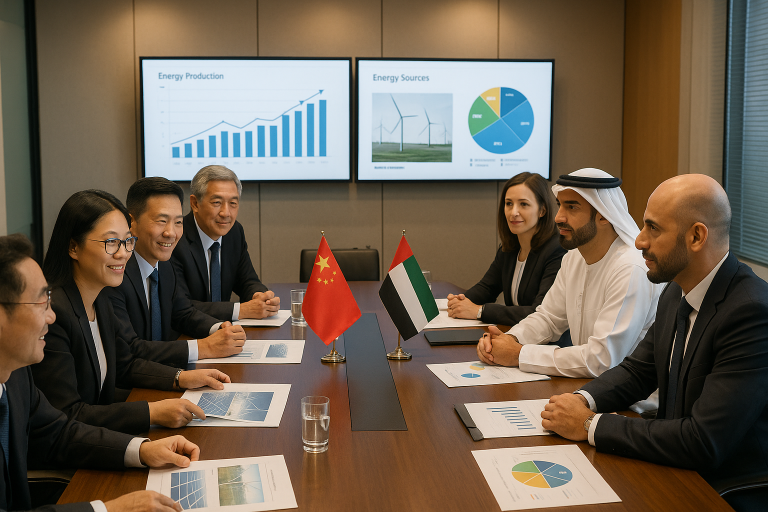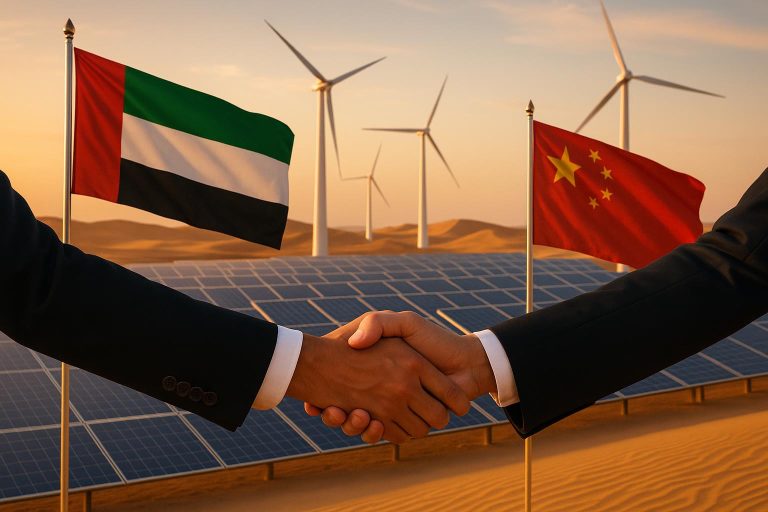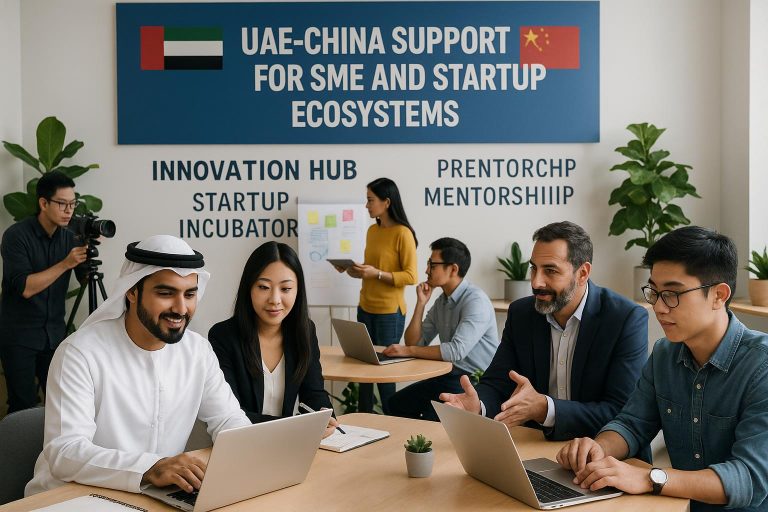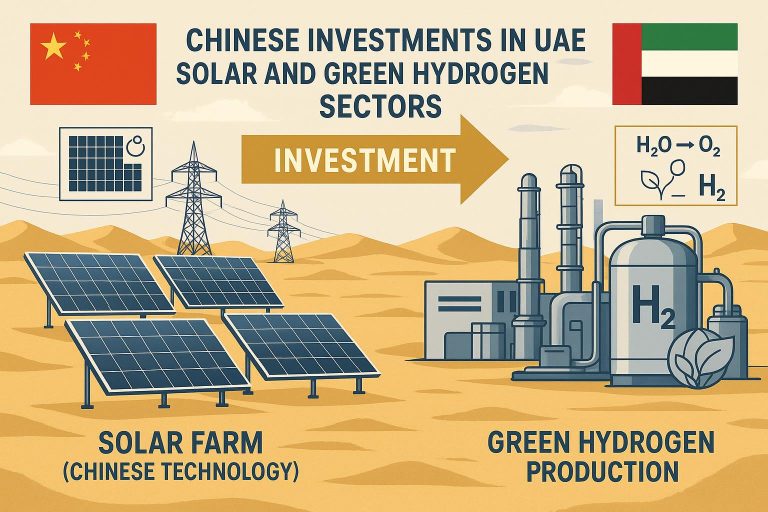From Pandemic Response to Biotech Partnership: How the UAE and China are Collaborating on Public Health and Life Sciences
Executive Summary
The United Arab Emirates (UAE) and China have significantly deepened their bilateral relationship, evolving from a comprehensive strategic partnership established in 2018 to a robust collaboration in public health and life sciences. This evolution, particularly accelerated by the global pandemic response, has seen bilateral trade reach a record $101.8 billion in 2024, with substantial Chinese investment in the UAE and vice versa. Key areas of cooperation now span medical technology, pharmaceuticals, and AI-driven healthcare solutions, exemplified by initiatives such as Mubadala’s acquisition of UCB Pharma’s China business and G42’s strategic role in vaccine development. While geopolitical complexities and regulatory differences present challenges, the partnership is poised for strategic growth through initiatives like the Belt and Road Initiative, financial integration, and leveraging the UAE’s position as a regional hub. This article explores the current landscape, opportunities, challenges, and future outlook of this vital collaboration, offering recommendations for sustained growth and mutual benefit.
Introduction
The relationship between the United Arab Emirates and the People’s Republic of China has undergone a remarkable transformation, ascending to a comprehensive strategic partnership in 2018. This elevated status reflects a shared vision for economic prosperity, technological advancement, and global influence. The economic ties underpinning this partnership are formidable, with bilateral trade soaring to an unprecedented $101.8 billion in 2024, marking an 800-fold increase since 1984. The UAE stands as China’s largest export market in the Middle East and its second-largest trading partner in the region, while China consistently remains the UAE’s foremost trading partner. This burgeoning economic relationship is further evidenced by the presence of over 15,000 Chinese firms operating within the UAE and a significant 96% increase in UAE investments in China, reaching $4.5 billion by the end of 2023.
Beyond traditional sectors, the partnership has increasingly diversified into new economy domains, with public health and life sciences emerging as critical pillars of cooperation. The global COVID-19 pandemic served as a catalyst, highlighting the imperative for international collaboration in health security and scientific innovation. This article delves into the multifaceted collaboration between the UAE and China in public health and life sciences, examining how their joint efforts have progressed from immediate pandemic response to a strategic, long-term biotech partnership. It will analyze the current landscape of this cooperation, identify key opportunities and strategic growth drivers, address inherent challenges and critical considerations, and provide a case study spotlight to illustrate practical applications. Finally, it will offer a future outlook and strategic recommendations to further solidify this crucial alliance.
The Current Landscape of Bilateral Cooperation
The comprehensive strategic partnership between the UAE and China has significantly broadened its scope, with public health and life sciences emerging as pivotal areas of collaboration, particularly catalyzed by the global COVID-19 pandemic. The initial response to the pandemic saw both nations engaging in critical cooperation, which laid a robust foundation for deeper, long-term partnerships in biotechnology and healthcare. This early collaboration included sharing expertise, medical supplies, and facilitating vaccine development, demonstrating a mutual commitment to global health security.
In the realm of Healthcare & Pharmaceuticals, the partnership has witnessed significant milestones. A notable example is the UAE’s sovereign investor, Mubadala, acquiring 100% ownership of UCB Pharma’s mature business in China. This strategic move underscores the UAE’s growing interest and investment in the Chinese pharmaceutical market, signaling a long-term commitment to the sector. Beyond acquisitions, the cooperation extends to broader partnerships in medical technology and pharmaceutical development, creating a fertile ground for investment opportunities across hospitals, biotechnology firms, and medical device manufacturing. These collaborations aim to enhance healthcare infrastructure, improve access to advanced medical treatments, and foster innovation in both nations.
Technology & AI in Healthcare represents another dynamic frontier of this bilateral relationship. UAE-based technology conglomerate G42 has played a crucial role, strategically positioning itself at the forefront of AI and technological advancements with global implications. G42’s involvement in the COVID-19 vaccine trials and manufacturing in the UAE (Hayat-Vax) with Sinopharm exemplifies the practical application of this technological partnership. Furthermore, the UAE and China have engaged in broader technology cooperation agreements, including a significant $5 billion partnership focused on AI, renewable energy, and infrastructure. This partnership is not limited to large-scale projects; Digital Dubai, for instance, has been actively exploring AI and smart city technologies in Shenzhen, China, indicating a shared vision for leveraging artificial intelligence to transform urban living and healthcare delivery. These initiatives highlight a concerted effort to integrate cutting-edge AI into public health systems, from diagnostics and treatment to predictive analytics and smart hospital management.
Opportunities and Strategic Growth Drivers
The deepening collaboration between the UAE and China in public health and life sciences is propelled by several strategic growth drivers and abundant opportunities. The Belt and Road Initiative (BRI) serves as a significant framework, with China investing $3.1 billion in various projects within the UAE. While traditionally focused on infrastructure, the BRI’s expansive vision can indirectly support health infrastructure development and connectivity, facilitating the movement of medical goods, expertise, and research. The Memorandum of Understanding (MoU) between Masdar and the China Silk Road Fund for renewable energy projects in BRI countries also presents an avenue for sustainable development that can underpin resilient healthcare systems.
Financial Integration plays a crucial role in fostering this biotech partnership. Cross-border investment facilitation has seen UAE investments in China surge by 96% to $4.5 billion by the end of 2023, reflecting growing confidence and strategic alignment. This financial synergy is further enhanced by Abu Dhabi-China fintech partnerships and cooperation through ETF launches, which streamline capital flows and support innovation in the life sciences sector. The collaboration between China’s CIPS and the UAE Central Bank on cross-border payment cooperation also facilitates smoother financial transactions, crucial for large-scale investments and joint ventures in healthcare.
The UAE’s strategic location and its robust network of Free Zones and Logistics infrastructure position it as an indispensable hub for Chinese life sciences companies seeking to expand into the Middle East, Africa, and beyond. Partnerships between JAFZA and Chinese free trade zones, along with collaborations involving DP World and Chinese port operators, create efficient supply chain corridors. The establishment of JINGDONG Property’s first Middle East logistics hub in Dubai, coupled with JD.com’s implementation of smart supply chain technologies, further solidifies the UAE’s role as a critical logistics gateway. This infrastructure is vital for the distribution of pharmaceuticals, medical devices, and other life science products, ensuring timely and efficient market access. The UAE’s advanced logistics capabilities can significantly reduce operational costs and enhance the reach of Chinese biotech innovations across new markets.
Furthermore, the shared commitment to technological advancement and digital transformation acts as a powerful growth driver. The $5 billion partnership between the UAE and China for AI, renewable energy, and infrastructure underscores a mutual ambition to leverage cutting-edge technologies. This includes the application of AI in drug discovery, personalized medicine, and public health management. The UAE’s proactive investment in AI, as demonstrated by entities like G42, positions it as a key partner for China in developing and deploying advanced healthcare solutions globally. The exploration of smart city technologies and digital health initiatives further illustrates a forward-looking approach to integrating technology into public health strategies, creating a dynamic ecosystem for biotech innovation and growth.
Challenges and Critical Considerations
Despite the significant progress and numerous opportunities, the UAE-China biotech partnership is not without its challenges and critical considerations. Navigating these complexities is essential for ensuring the long-term sustainability and effectiveness of the collaboration.
One primary challenge stems from Geopolitical Complexities. The UAE, while fostering strong ties with China, also maintains strategic relationships with Western nations, particularly the United States. Entities like G42, which actively collaborates with both Chinese and American partners, find themselves in a delicate balancing act. This strategic positioning can become a source of tension, particularly in sectors deemed sensitive, such as advanced technology and biotechnology, where concerns over data security, intellectual property, and technological dominance are prevalent. Managing these geopolitical sensitivities requires astute diplomacy and clear communication to avoid potential conflicts of interest or external pressures that could impede collaboration.
Another critical consideration involves Regulatory and Intellectual Property (IP) Protection. Both the UAE and China have distinct regulatory frameworks governing pharmaceuticals, medical devices, and biotechnology. Harmonizing these regulations or establishing mutually recognized standards is crucial for facilitating cross-border research, development, and market access. Furthermore, robust intellectual property protection is paramount for fostering innovation in the biotech sector. Ensuring that innovations developed through joint ventures are adequately protected and that IP rights are respected in both jurisdictions is vital for attracting further investment and encouraging cutting-edge research. Discrepancies in IP enforcement or regulatory approval processes could create hurdles for companies operating across both markets.
Finally, Data Security and Privacy present a significant challenge, especially in the context of AI-driven healthcare collaborations. The sharing and processing of sensitive health data across borders raise concerns about data governance, privacy standards, and potential misuse. Establishing secure data exchange protocols, adhering to international best practices for data protection, and building trust in data handling mechanisms are imperative. As AI becomes more integrated into diagnostics, treatment, and public health surveillance, ensuring the ethical and secure management of patient data will be a continuous and evolving challenge that requires proactive and collaborative solutions.
Case Study Spotlight
The collaboration between the UAE and China in public health and life sciences is best exemplified by concrete projects that have delivered tangible results. Two prominent examples highlight the depth and strategic nature of this partnership.
One of the most significant collaborations during the pandemic was the partnership between G42 and Sinopharm for the COVID-19 vaccine trials and subsequent manufacturing in the UAE. This initiative led to the development and production of Hayat-Vax, the first indigenous COVID-19 vaccine in the Middle East. The UAE hosted the Phase III clinical trials for Sinopharm’s inactivated vaccine, involving over 31,000 volunteers. This rapid and successful collaboration not only contributed significantly to global vaccine efforts but also showcased the UAE’s capability as a regional hub for biotech research and manufacturing. The project demonstrated a seamless integration of Chinese scientific expertise with UAE’s logistical capabilities and regulatory support, providing a blueprint for future joint ventures in vaccine development and biopharmaceutical production.
Another compelling case is Mubadala’s acquisition of 100% ownership of UCB Pharma’s mature business in China. This strategic investment by the UAE’s sovereign wealth fund into the Chinese pharmaceutical market signifies a long-term commitment to the sector. The acquisition allows Mubadala to tap into China’s vast and rapidly growing healthcare market, particularly in areas of high unmet medical need. It also provides a platform for knowledge exchange, technology transfer, and further investment in Chinese biotech companies. This move underscores the UAE’s proactive approach to diversifying its economy and establishing itself as a key player in the global life sciences industry, leveraging its financial strength to forge strategic alliances with leading Chinese enterprises.
Future Outlook and Strategic Recommendations
The trajectory of the UAE-China partnership in public health and life sciences points towards a future characterized by deeper integration and expanded collaboration. To maximize the mutual benefits and navigate emerging complexities, several strategic recommendations can be considered.
Firstly, there is immense potential for Deepening Research and Development (R&D) Collaboration. Both nations should actively pursue joint research initiatives in cutting-edge areas such as genomics, personalized medicine, advanced diagnostics, and novel drug discovery. Establishing joint research centers, funding collaborative projects, and facilitating academic exchanges can accelerate scientific breakthroughs and address global health challenges more effectively. This could involve shared access to research infrastructure and pooling intellectual resources to tackle complex diseases.
Secondly, fostering Talent Exchange and Development is crucial. Programs aimed at knowledge sharing, joint training, and professional development in biotechnology, AI in healthcare, and pharmaceutical manufacturing can build a skilled workforce in both countries. This includes scholarships for students, exchange programs for researchers and medical professionals, and vocational training initiatives to bridge skill gaps. A robust talent pipeline will be essential for sustaining innovation and growth in the life sciences sector.
Thirdly, the UAE’s Hub Status should be further leveraged. The UAE can serve as an ideal launchpad for Chinese biotech firms looking to expand their footprint into the Middle East, Africa, and even European markets. By offering attractive investment incentives, streamlined regulatory processes, and world-class infrastructure, the UAE can become a preferred destination for Chinese companies seeking internationalization. This includes facilitating market entry, providing logistical support, and connecting Chinese innovators with regional healthcare networks.
Finally, a continued focus on New Technologies will be paramount. Beyond traditional biotech, exploring innovative applications such as eVTOL aircraft (flying taxis) for rapid medical logistics, and smart agriculture technologies for food security, which directly impacts public health, can open new avenues for collaboration. For instance, the $1 billion deal for 350 flying taxis between the UAE and China could revolutionize emergency medical transport and delivery of critical supplies. Similarly, advanced agricultural projects like the Silal and China’s Shouguang Vegetable Group partnership in smart farming can enhance nutritional security, a fundamental aspect of public health. These forward-looking initiatives demonstrate a commitment to integrating diverse technological advancements for holistic societal well-being. By embracing these recommendations, the UAE and China can solidify their position as leaders in global health innovation and contribute significantly to a healthier future for their populations and beyond.
Conclusion
The journey of collaboration between the United Arab Emirates and China has evolved significantly, transitioning from a broad comprehensive strategic partnership to a focused and impactful alliance in public health and life sciences. This evolution, accelerated by the shared experience of the global pandemic, has not only strengthened bilateral ties but also positioned both nations as key players in addressing global health challenges. The remarkable growth in bilateral trade and investment underscores a deep economic interdependence, providing a solid foundation for further cooperation in critical sectors.
From strategic investments like Mubadala’s acquisition in China’s pharmaceutical sector to groundbreaking collaborations in AI-driven healthcare and vaccine development, the partnership demonstrates a clear commitment to innovation and mutual growth. While challenges such as geopolitical complexities, regulatory harmonization, and data security require careful navigation, the proactive engagement from both sides suggests a strong resolve to overcome these hurdles. The strategic alignment with initiatives like the Belt and Road, coupled with the UAE’s role as a logistical and financial hub, creates a fertile environment for sustained growth.
Looking ahead, the UAE-China biotech partnership is poised for even greater impact through deepened R&D collaboration, robust talent exchange programs, and the strategic leveraging of the UAE’s unique position as a gateway to broader markets. By embracing new technologies and fostering an ecosystem of innovation, both nations are not only enhancing their own health security and economic diversification but also contributing significantly to global advancements in life sciences. This enduring partnership serves as a testament to the power of international cooperation in building a healthier and more prosperous future.
References
[1] UAE-China Bilateral Investment Research Findings (Provided by User)

